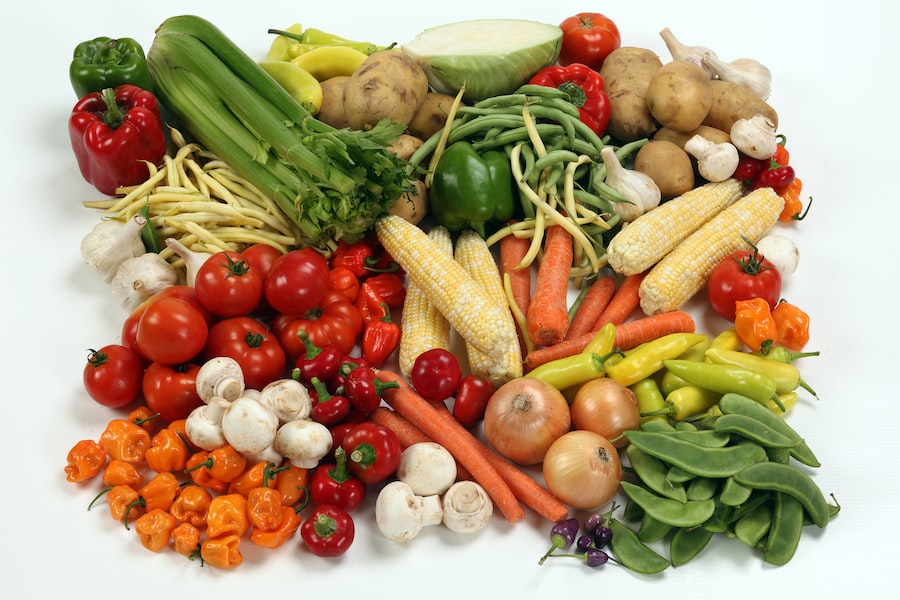From Table Scraps to Garden Bounty: How to Grow Celery from a Stalk

Regrowing vegetables from scraps is a sustainable and cost-effective way to enjoy fresh produce right from your own garden. Not only does it reduce food waste, but it also allows you to have a continuous supply of vegetables without having to buy them from the store. One vegetable that is particularly easy to regrow at home is celery. With just a few simple steps, you can turn a leftover celery stalk into a thriving plant that will provide you with crisp and flavorful celery for months to come.
Key Takeaways
- Turning table scraps into garden bounty is a great way to reduce waste and save money.
- Celery is a great choice for regrowing because it is easy to grow and can be used in a variety of dishes.
- To prepare the celery stalk for planting, cut off the bottom and place it in water until roots form.
- Choosing the right soil and container is important for the health and growth of your celery plant.
- Watering and fertilizing your celery plant regularly, and managing pests and diseases, will help ensure a successful harvest.
Why Choose Celery for Regrowing?
Celery is not only a delicious and versatile vegetable, but it also offers numerous health benefits. It is low in calories and high in fiber, making it an excellent choice for those looking to maintain a healthy weight or improve digestion. Celery is also rich in vitamins and minerals, including vitamin K, vitamin C, potassium, and folate. These nutrients contribute to overall health and can help reduce the risk of chronic diseases such as heart disease and cancer.
In addition to its health benefits, regrowing celery at home can save you money. Celery can be quite expensive to buy at the grocery store, especially if you consume it regularly. By regrowing your own celery, you can significantly reduce your grocery bill while still enjoying the same fresh and flavorful vegetable.
Preparing the Celery Stalk for Planting
To regrow celery from scraps, you’ll need to start with a fresh celery stalk. Look for a stalk that is firm and has a good amount of leaves attached to it. Avoid stalks that are wilted or have brown spots, as these may not regrow successfully.
Once you have selected your celery stalk, cut off the base of the stalk, leaving about 2 inches of the bottom intact. Place the cut end in a shallow dish or jar filled with water, making sure that the bottom of the stalk is submerged. Place the dish or jar in a sunny spot, such as a windowsill, and change the water every few days to keep it fresh.
Choosing the Right Soil and Container
| Soil Type | Container Type | Benefits |
|---|---|---|
| Loamy Soil | Plastic Container | Retains moisture and nutrients well |
| Sandy Soil | Terra Cotta Container | Allows for good drainage and aeration |
| Clay Soil | Wooden Container | Provides good insulation and retains moisture |
| Peat Soil | Metal Container | Acidic soil that is great for acid-loving plants |
After a week or two, you will start to see new growth at the center of the celery stalk. Once the new growth reaches about 2 inches in height, it’s time to transplant the celery into soil. Choose a pot or container that is at least 8 inches deep and has drainage holes at the bottom. Celery has long roots, so a deeper container will allow for proper root development.
When it comes to soil, celery prefers a rich and well-draining mix. You can use a pre-made potting mix or create your own by combining equal parts of compost, peat moss, and perlite or vermiculite. Fill the container with the soil mixture, leaving about an inch of space at the top.
Planting the Celery Stalk
To plant the celery stalk, make a hole in the soil that is deep enough to accommodate the entire stalk. Gently place the stalk into the hole, making sure that the new growth is above the soil line. Press the soil around the stalk to secure it in place.
Celery requires full sun to grow properly, so choose a location that receives at least 6 hours of direct sunlight each day. If you don’t have a sunny spot in your garden, you can also grow celery indoors near a south-facing window or under grow lights.
Watering and Fertilizing Your Celery Plant

Celery requires consistent moisture to grow well, so it’s important to keep the soil evenly moist throughout the growing season. Water your celery plant regularly, aiming to keep the soil consistently damp but not waterlogged. Avoid letting the soil dry out completely between waterings, as this can cause stress to the plant.
In addition to regular watering, celery also benefits from regular fertilization. Use a balanced organic fertilizer, such as a 10-10-10 or 14-14-14 blend, and apply it according to the package instructions. Fertilize your celery plant every 4-6 weeks during the growing season to provide it with the nutrients it needs to thrive.
Managing Pests and Diseases in Your Celery Garden
Like any garden plant, celery is susceptible to pests and diseases. Common pests that can affect celery include aphids, slugs, and snails. To prevent these pests from damaging your plants, regularly inspect your celery for signs of infestation and take action at the first sign of trouble. You can use organic pest control methods such as handpicking pests, using insecticidal soap or neem oil, or introducing beneficial insects like ladybugs or lacewings.
Celery can also be prone to diseases such as leaf blight and root rot. To prevent these diseases, make sure to provide adequate air circulation around your plants by spacing them properly and avoiding overcrowding. Water your celery at the base of the plant rather than overhead to minimize the risk of fungal diseases. If you notice any signs of disease, such as yellowing leaves or wilting, take action immediately by removing affected plants or treating them with appropriate fungicides.
Harvesting Your Celery Crop
Celery is typically ready for harvest about 3-4 months after planting. The stalks should be firm and crisp, with a bright green color. To harvest your celery, use a sharp knife or garden shears to cut the stalks at the base, just above the soil line. Leave any small inner stalks intact so that they can continue to grow.
It’s important to note that celery is a cool-season crop and does not tolerate high temperatures well. If you live in a hot climate, it’s best to harvest your celery before the temperatures rise too much, as this can cause the stalks to become tough and bitter.
Storing and Using Your Homegrown Celery
Once you have harvested your celery, it’s important to store it properly to maintain its freshness and flavor. Celery can be stored in the refrigerator for up to 2 weeks. To keep it fresh, wrap the stalks tightly in plastic wrap or place them in a sealed plastic bag. You can also store celery by cutting it into smaller pieces and freezing them for later use.
Homegrown celery can be used in a variety of recipes, from soups and stews to salads and stir-fries. Its crisp texture and mild flavor make it a versatile ingredient that can enhance the taste of any dish. Try adding celery to your favorite recipes or experiment with new dishes to fully enjoy the fruits of your labor.
Enjoying the Fruits of Your Labor
Regrowing celery at home is a rewarding and sustainable way to enjoy fresh produce right from your own garden. By following a few simple steps, you can turn a leftover celery stalk into a thriving plant that will provide you with crisp and flavorful celery for months to come. Not only does regrowing celery save you money, but it also allows you to enjoy the numerous health benefits that this versatile vegetable has to offer. So why not give it a try? Start regrowing your own celery today and enjoy the rewards of your efforts.
If you’re interested in learning more about growing celery from the stalk, you might find this article from Lawn World helpful. They provide a comprehensive guide on how to grow celery in your own backyard. From preparing the soil to planting the stalks and caring for the plants, this article covers all the essential steps. Check out their website for more gardening tips and tricks. Click here to read the full article.
FAQs
What is celery?
Celery is a vegetable that belongs to the Apiaceae family. It is commonly used in cooking and is known for its crunchy texture and mild flavor.
Can you grow celery from the stalk?
Yes, you can grow celery from the stalk. It is a simple and easy process that can be done at home.
What do you need to grow celery from the stalk?
To grow celery from the stalk, you will need a celery stalk, a container, water, and soil.
How do you grow celery from the stalk?
To grow celery from the stalk, cut off the bottom of the celery stalk and place it in a container with water. Change the water every few days and wait for the celery to sprout roots. Once the roots have grown, plant the celery in soil and water regularly.
How long does it take to grow celery from the stalk?
It can take up to two weeks for the celery to sprout roots and another two to three months for the celery to fully mature.
What are the benefits of growing celery from the stalk?
Growing celery from the stalk is a cost-effective way to grow your own vegetables at home. It also allows you to control the quality of the celery and ensures that it is free from harmful pesticides and chemicals.



